These delicious German potato dumplings (Kartoffelkloesse) are amazing when served alongside rich gravy and in place of mashed potato with tons of dishes. This recipe uses just 4 ingredients and five steps to delicious potato dumplings every time. Plus, this recipe is gluten-free and vegan!
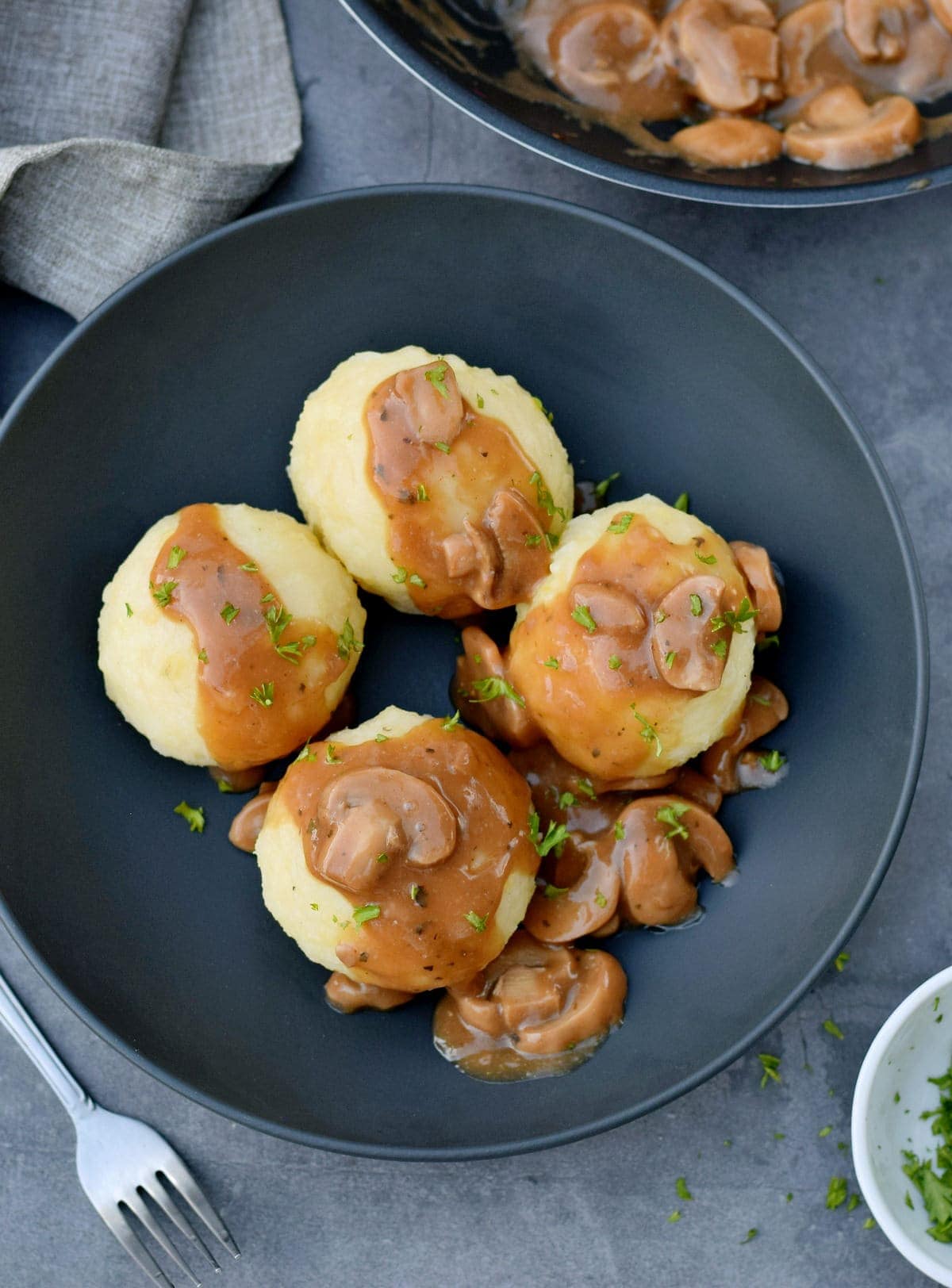
Comforting German Potato Dumplings
Right now, I’m completely and utterly in the mood for comfort food and good classics from my childhood. These German potato dumplings (also referred to as Kartoffelklöße, and/or Kartoffelknödel – though English speakers often refer to them as Knoedel or Kloesse) are extremely common in Germany.
They can be served alongside many dishes but are especially popular with Sunday roasts and at Christmastime, along with cooked red cabbage (Rotkraut) and meatloaf (Sauerbraten). Luckily, they’re no less delicious when served as part of a meat-free, vegan meal topped with tons of gravy!
However, even though this post is inspired by German-style potato dumplings, similar versions of this dish are made throughout Europe. This includes Poland, where they’re called ‘Kopytka’ and are similar in shape to gnocchi, and Hungary.
In fact, my family is from the Czech Republic, where this dish is also popular and called “bramborové knedlíky.” There, we made them in a log shape, like a baguette, and then sliced.
Let me know in the comments if your own country has a similar dish that I haven’t mentioned.
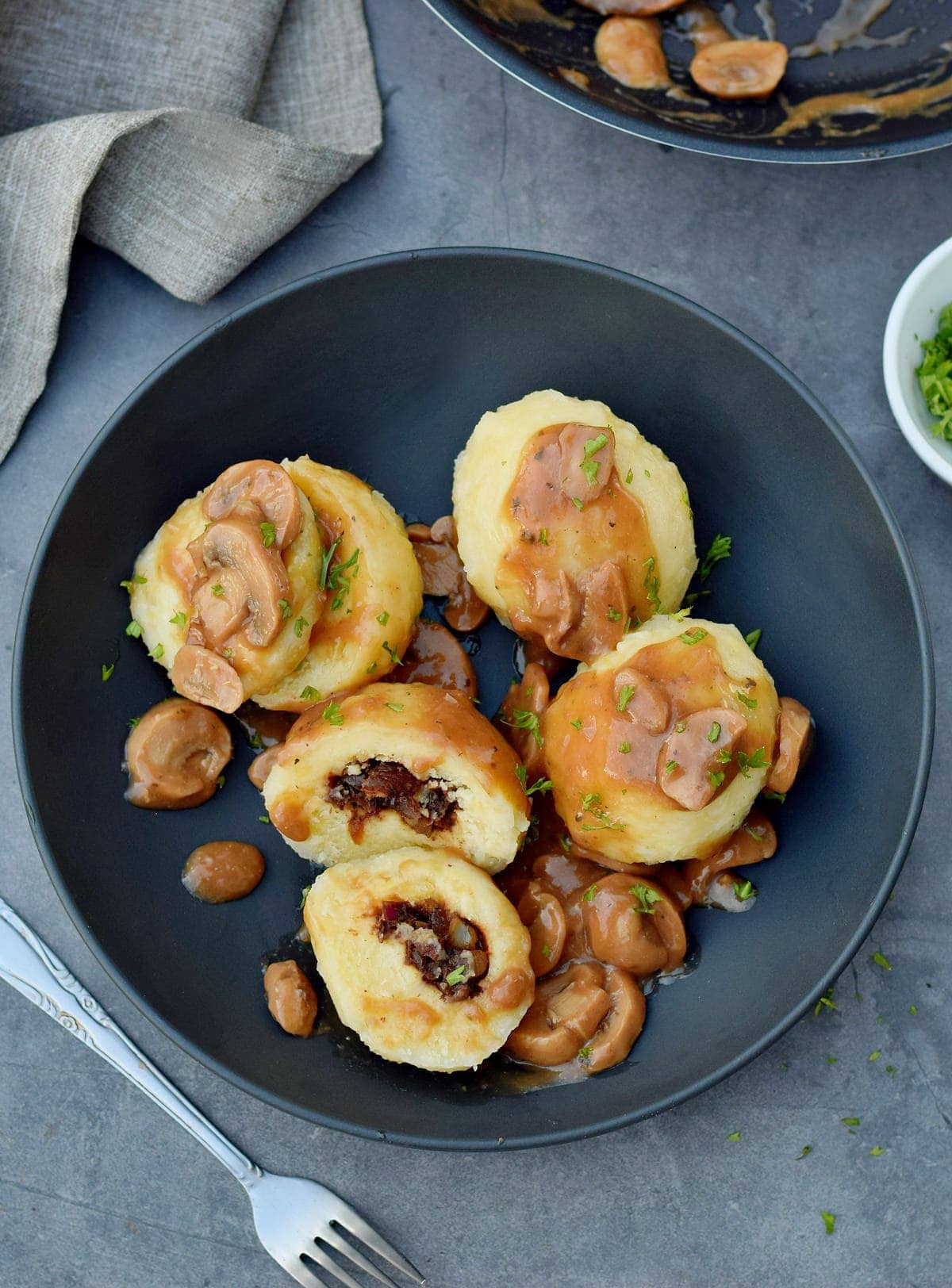
What are Potato Dumplings?
All the above being said, if you’re not already aware of this popular side dish, you may be wondering what they are.
As stated, there are many versions of this dish across Germany (in fact, there are many types of dumplings, in general, in Germany!). Some are made up almost entirely of potato, whereas others include extras such as bread, flour, starch, and even eggs. There are also generally a few different versions of preparing the potatoes for these dumplings, including using 100% boiled potatoes, using raw potatoes, or using a 50/50 blend. I’ve used a 100% boiled potato version, combining potato, starch, salt, and nutmeg for a simple but delicious potato dumpling.
For this recipe, the potato dough is formed into balls and then cooked in salted water with results that are similar to, yet not precisely, like fresh potato gnocchi yet softer and fluffier.
You can also stuff the dumplings in various ways – though this isn’t as common. I like to stuff them with a mixture of mushrooms, onions, and garlic!
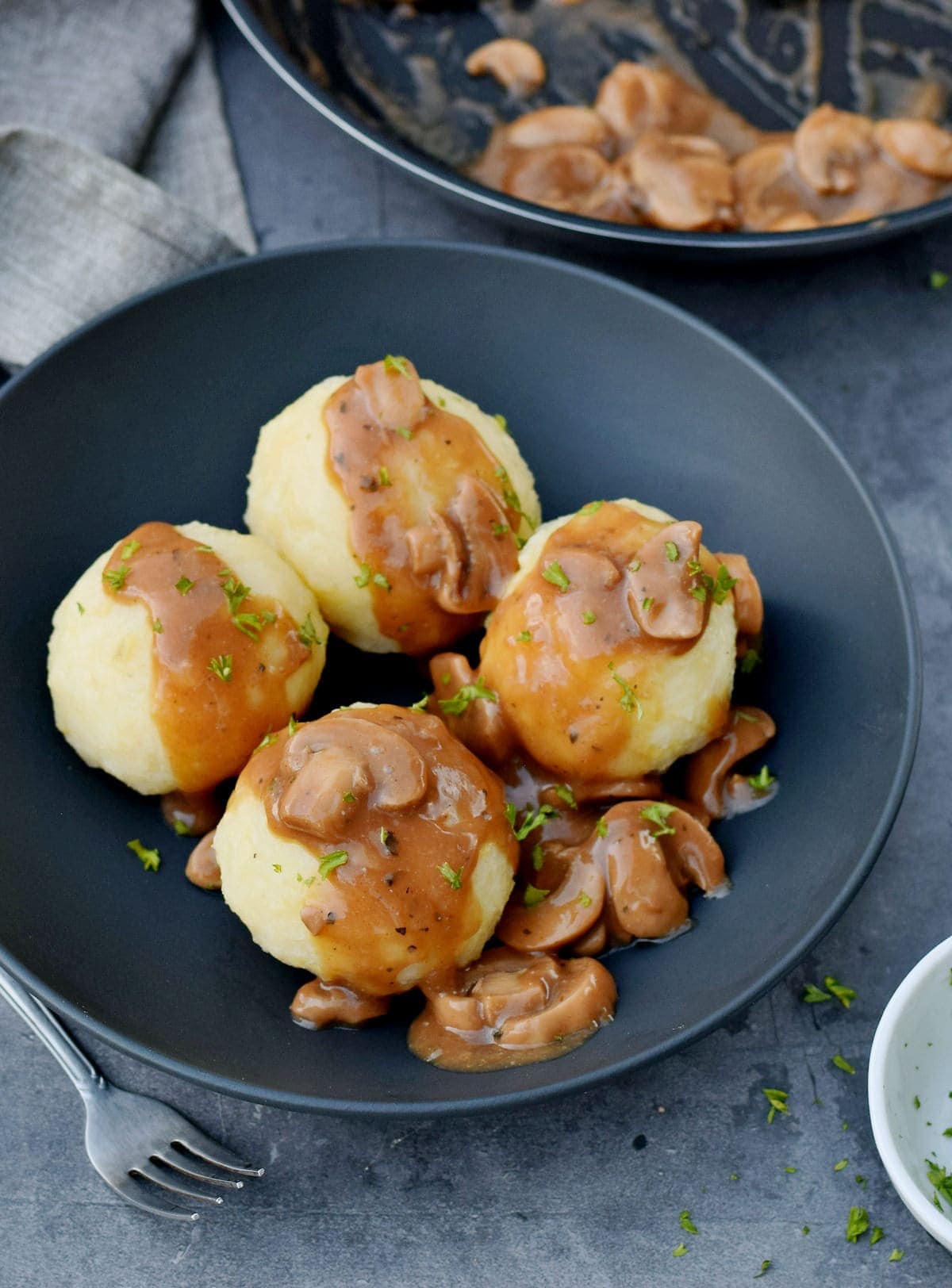
The Ingredients
- Potatoes – The key to achieving the correct dumpling texture is using the right potatoes that won’t retain too much water when boiled and will hold their shape. It’s best to use all-purpose potatoes like Yukon Gold, a starchy potato, like Russet. If using waxy potatoes, then you’ll need to use more starch.
- Starch – Potato starch is my go-to for this recipe, though you could also use tapioca flour/starch (they are the same ingredient, though named differently in different places) or cornstarch.
I’ve tested this potato dumplings recipe twice with tapioca flour, twice with potato starch, and twice with cornstarch. Potato starch works amazingly, with tapioca starch being a close second. The first time I experimented with cornstarch, I boiled the potatoes once they’d been peeled, and the results were quite mushy. The second time, I use non-peeled potatoes when cooking, as they turned out great!
- Nutmeg – Just a dash of nutmeg adds classic flavor to the potato balls.
- Salt – Don’t be stingy when salting the water or potatoes, for superior flavor.
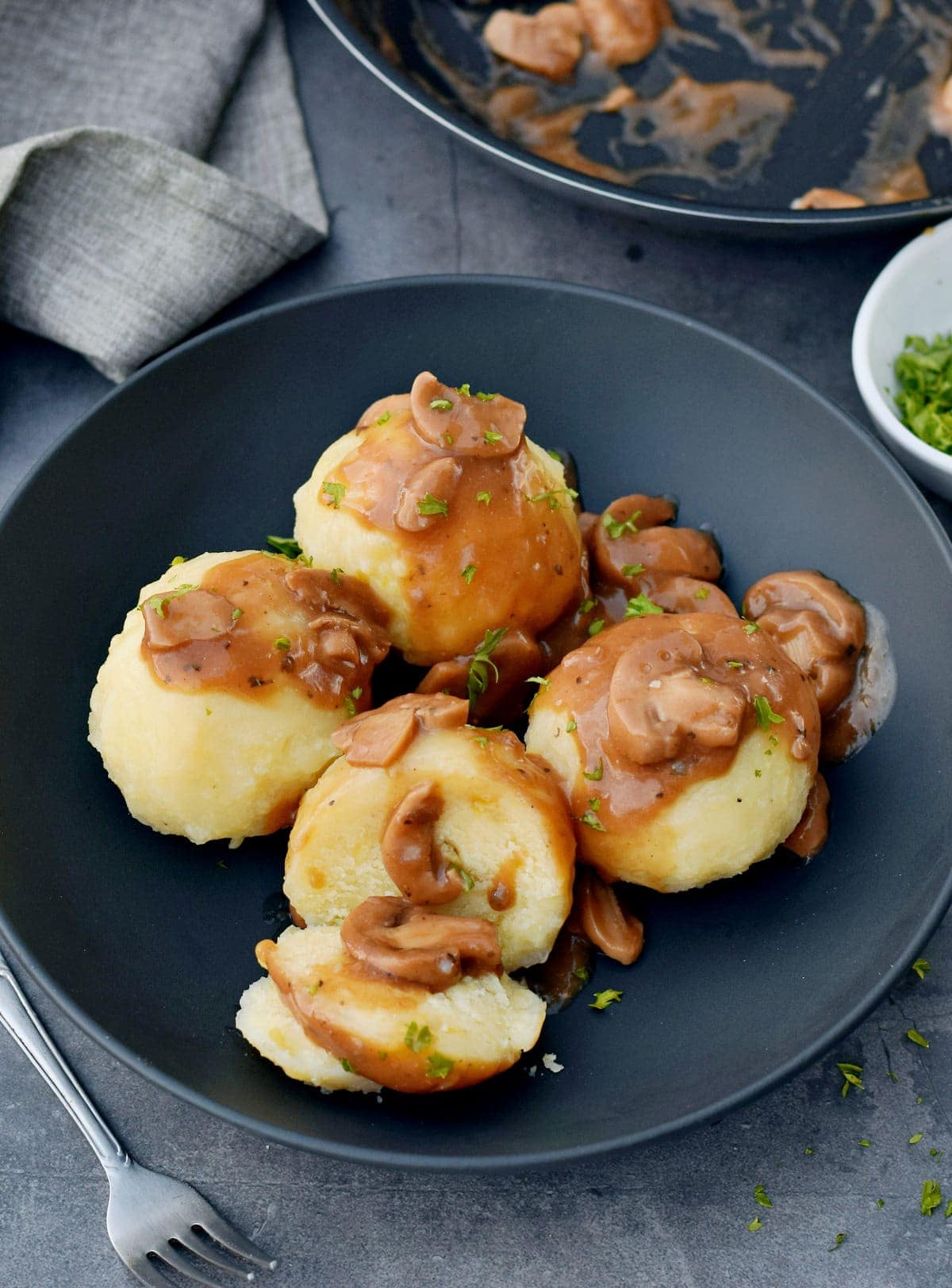
How To Make Potato Dumplings – Step-By-Step
For the full ingredients list, ingredient measurements, and nutritional information, then please read the recipe card below.
Step 1. Begin by cooking the potatoes whole with the skin on, in a large pot with boiling water until fork tender.
Step 2. Allow the potatoes to cool slightly and then peel the potatoes (I had 750g of potato, once cooked and peeled. Then mash the potatoes with a potato masher or ricer.
Step 3. Add the potato starch, salt, and nutmeg. Then use your hands to knead the mixture into a smooth dough. Meanwhile, bring a large pot of salted water to a gentle simmer (never allow it to boil).
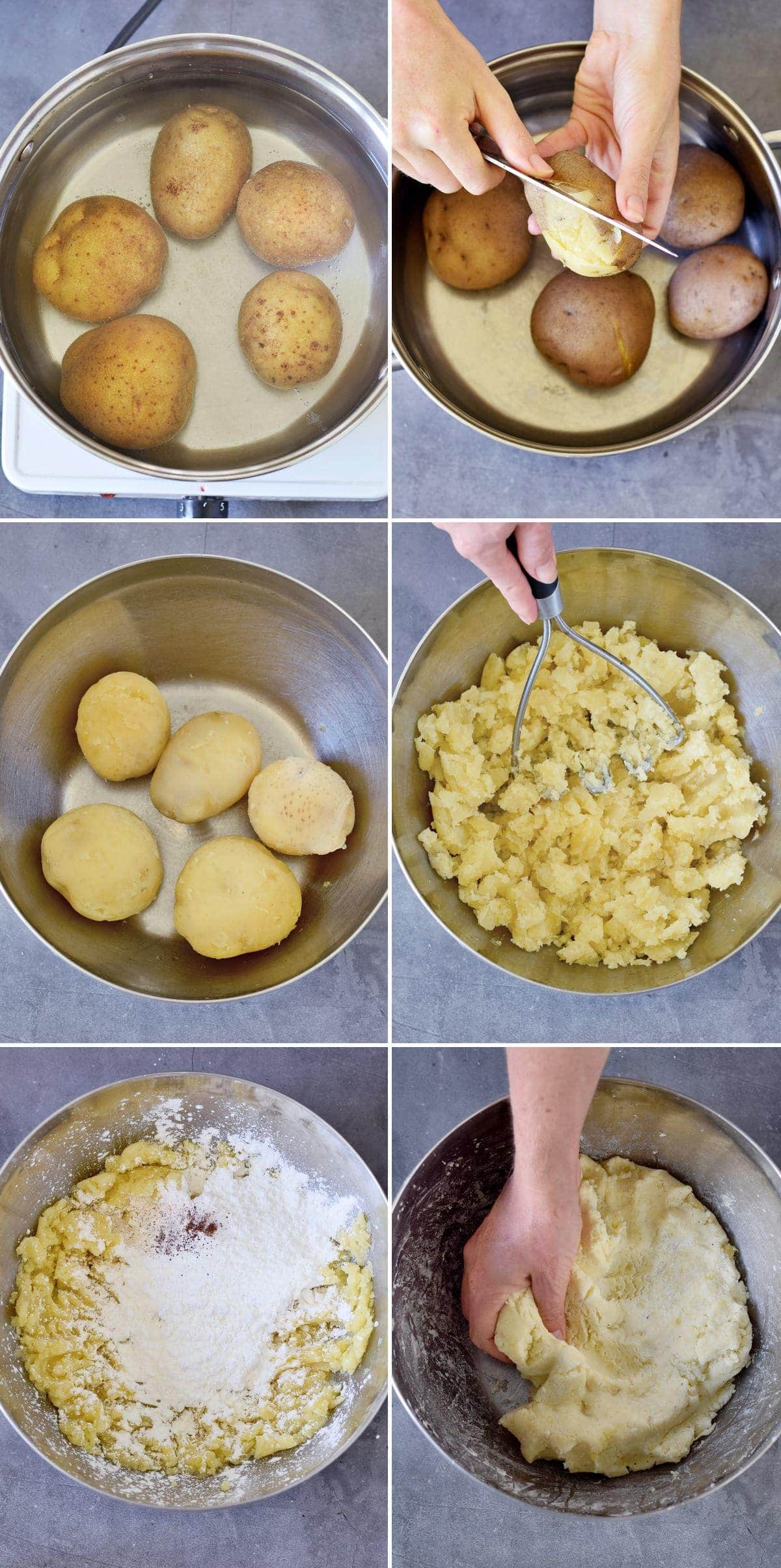
Step 4. Wet your hands with a little water (this will stop the dough from sticking to your hands), then divide the dough into 6-8 portions and shape into potato balls. You can add a filling, but this step is optional! I only filled two and left the others unfilled.
Step 5. Reduce the heat of the pot – it needs to be hot but not boiling (this is very important!). Then carefully add the dumplings to the pot and allow them to cook for 15 minutes. They usually tend to sink initially and then rise to the surface when ready (though they can emerge before cooked through, so I always cook for 15 minutes).
Step 6. Once ready, remove them from the water with a slotted spoon, serve, and enjoy!
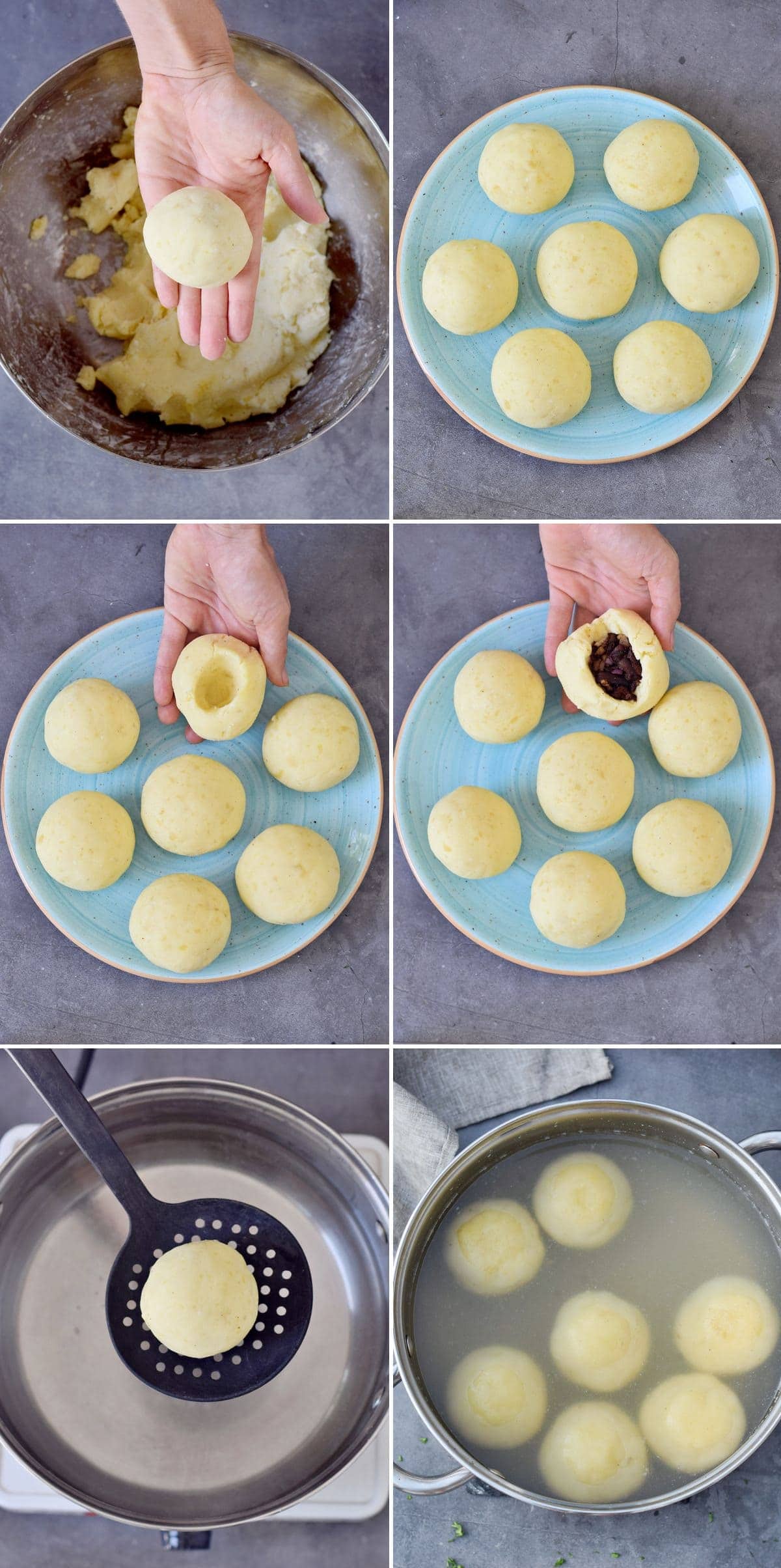
How To Serve
As I mentioned above, there are tons of ways to add these German potato dumplings to your meals. Traditionally, they are served with lashings of gravy, meat, and often red cabbage or Sauerkraut.
However, you can also use these in place of mashed potatoes or roast potatoes in tons of meals.
Personally, I love to serve them alongside Vegan Meatloaf and this Flavorful Vegan Gravy. Even better if you pile your plate high with extra green veggies like broccoli, green beans, or peas.
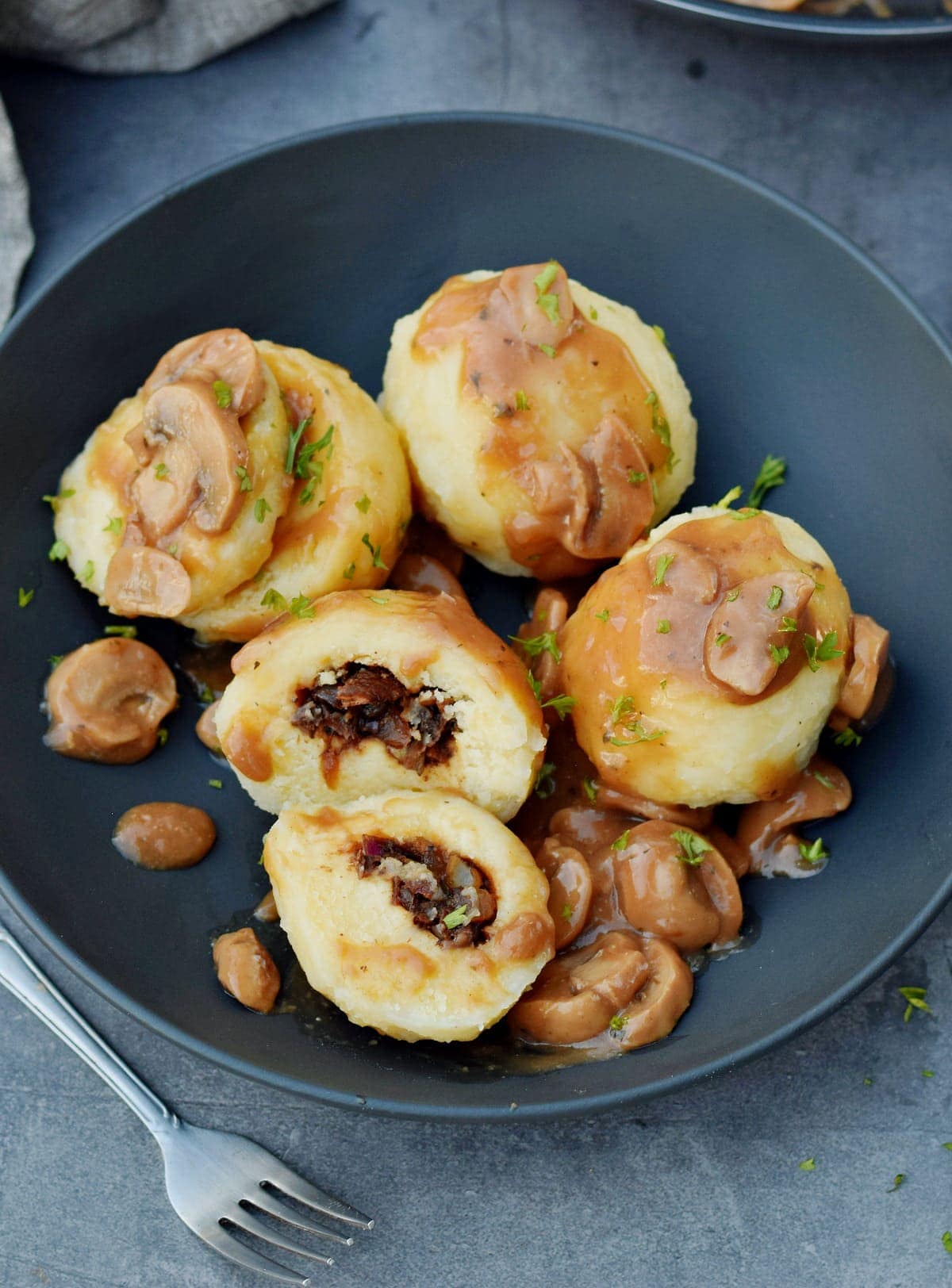
How To Store
You can eat these dumplings immediately, while warm, or leave leftovers to chill in the fridge overnight and then slice and fry in vegan butter the following day, like gnocchi (then serve with more gravy!).
You can also freeze any extra cooked mashed potato dumplings for around 2 months by first cutting them in half, then placing them on a parchment paper-lined tray (not touching). Once frozen, you can transfer them to an airtight container.
You can then steam them from frozen or reheat either in a frying pan or microwave.
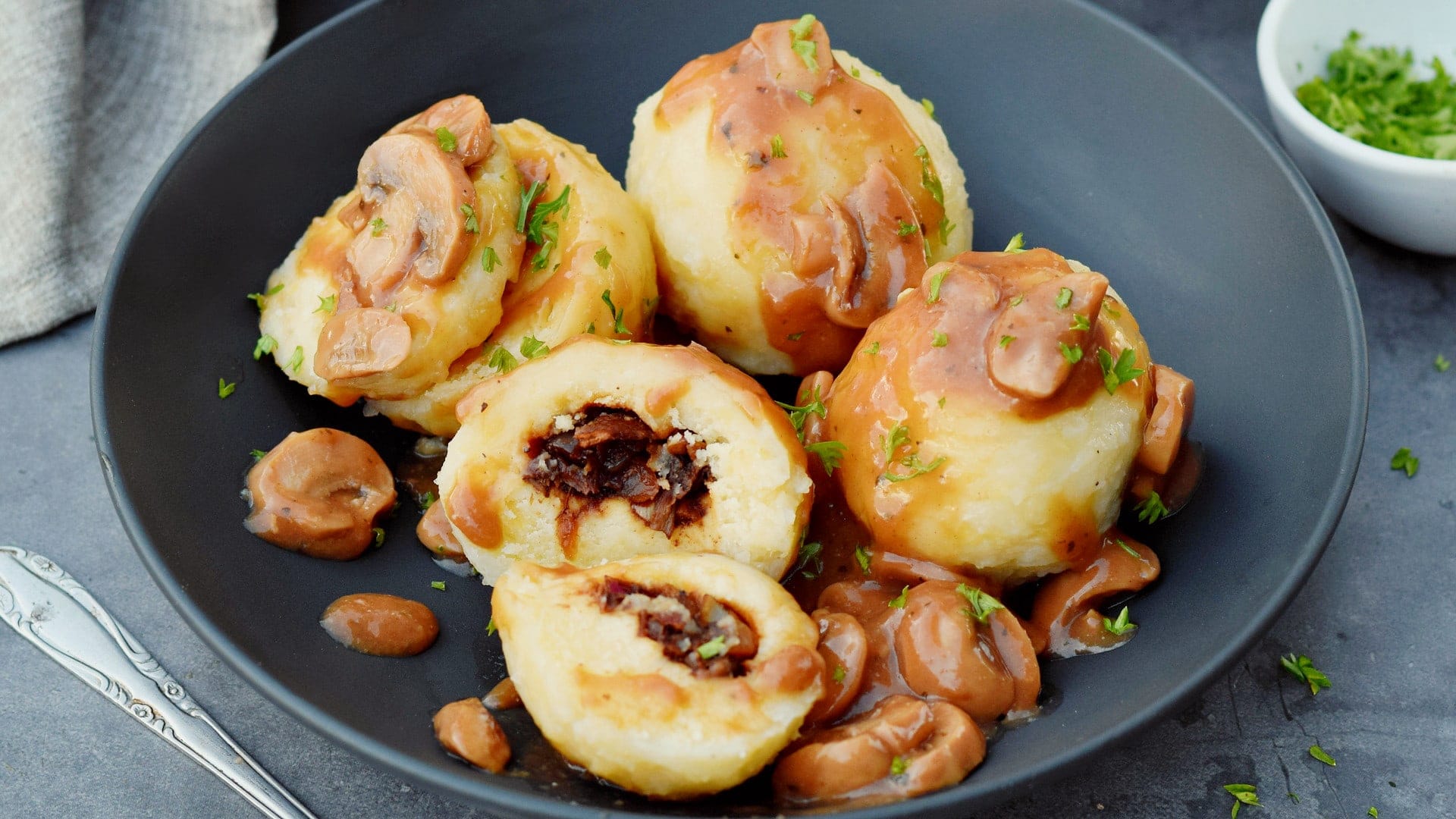
Recipe Notes
- Don’t allow the water to boil while cooking the dumplings. Otherwise, they will fall apart and get mushy, no matter which starch you use!
- You can prepare the potato the day before by cooking and mashing/ricing the potato, then allowing it to chill covered in the fridge until you’re ready to prepare the dough and dumplings.
- Some people recommend chilling the dumplings for an hour or so before boiling them, however, I made the experience that it’s better not doing that, as they tend to get stickier then.
- If you’re experimenting with new potato varieties or different starches, then you can avoid ruining an entire batch of dumplings by cooking a ‘test’ dumpling first. Simply boil one test dumpling first to make sure that it doesn’t fall apart. If it does, then add extra starch to the dough before rolling the remainder of the balls – just don’t add too much, or they can become a little rubbery rather than fluffy.
- It’s possible to stuff these mashed potato dumplings with a variety of fillings – such as a mushroom and onion filling. You could even simply place a bread crouton in the center of each dumpling. As well as adding a hidden surprise, this also helps to soak up some moisture of the dough and make sure the dumpling is cooked through.
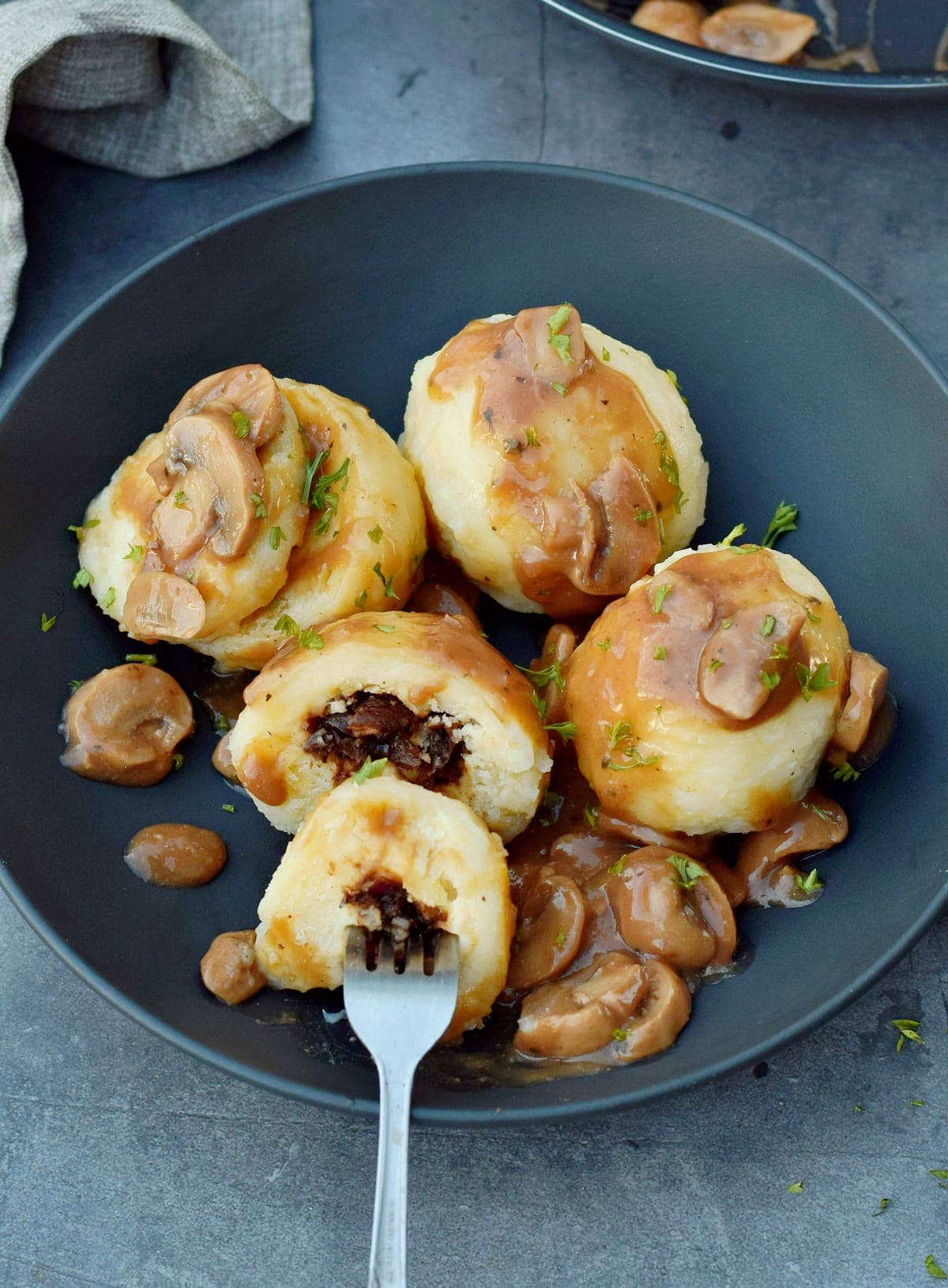
Other popular German Recipes
- Creamy German Cucumber Salad (Gurkensalat)
- German Schupfnudeln (Vegan Potato Noodles)
- Caramelized Onion Tart (German Zwiebelkuchen)
- Vegan Sausage (German Bratwurst)
- Vegan Hash Browns (Kartoffelpuffer)
- German Potato Soup (Kartoffelsuppe)
And for dessert…
- Steamed Yeast Dumplings | German Dampfnudel
- Easy Apple Strudel | German Apfelstrudel
- Homemade German Marzipan
- German Zimtsterne
If you give this potato dumpling recipe a try, I’d love a comment and recipe rating below. Also, don’t forget to tag me in re-creations on Instagram or Facebook with @elavegan and #elavegan – I love seeing your recreations.
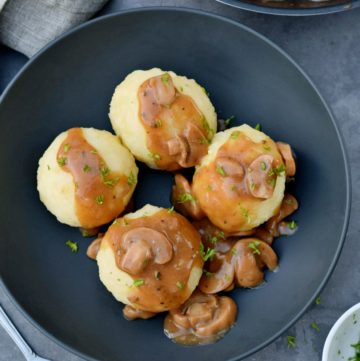
German Potato Dumplings
Ingredients
- 800 g (28.22 oz) potatoes (see notes)
- 120 g (4.23 oz) potato starch (see notes)
- Salt to taste
- Pinch of nutmeg
Instructions
- You can watch the video in the post for visual instructions.Cook potatoes with the peel in a large pot with boiling water until fork-tender, then drain the water.
- Let cool, then peel the potatoes (the weight of the cooked and peeled potatoes was 750 g or 26.45 oz). Mash them with a potato masher.
- Add potato starch, salt, and nutmeg. Use your hands to knead the mixture into a smooth dough. Meanwhile, bring water and enough salt in a large pot to a simmer.
- Wet your hands, take a handful of dough, and shape it into a ball. The recipe makes 6-8 potato dumplings, depending on how large you make them. You can fill some of them or leave them all plain (check the notes below for my mushroom stuffing recipe).
- Reduce the heat of the pot. The water should be hot (about 80-85 degrees C resp. 176-185 degrees F) but it shouldn't boil or simmer. Carefully add the potato balls into the pot and let them cook in the water for 15 minutes, they will rise to the surface.
- Remove them from the water with a slotted spoon. Serve and enjoy!
Notes
- Potatoes: It's best to use all-purpose potatoes like Yukon Gold or starchy potatoes like Russet. If you use waxy potatoes, you'll need to use more potato starch. If the mixture turns out too dry, simply add a little water.
- Starch: I tested the recipe twice with potato starch, twice with tapioca flour (tapioca starch is the same thing, just a different name), and also twice with cornstarch. The recipe works very well with potato starch and also great with tapioca flour. The first time I made them with cornstarch, they turned out quite mushy (that time I peeled the potatoes before I cooked them) but the second time they turned out fine (I didn't peel the potatoes before cooking).
- The potato dumplings are a little sticky/gooey at first (especially the ones made with tapioca flour), but once they cool, they firm up nicely.
- It's VERY important that the water doesn't boil, otherwise, the dumplings might fall apart and get mushy, no matter which starch you use!
- Serve with this Vegan Meatloaf and this Mushroom Gravy.
- Check the step-by-step photos, storing instructions, and helpful tips in the above blog post.
- 200 grams (7.05 oz) fresh mushrooms
- 1/2 medium onion
- 2 garlic cloves
- 1/2 tbsp soy sauce or tamari or coconut aminos
- Onion powder, smoked paprika, cumin, salt & pepper to taste
Nutrition information is an estimate and has been calculated automatically
If you are using Pinterest, feel free to pin the following photo:
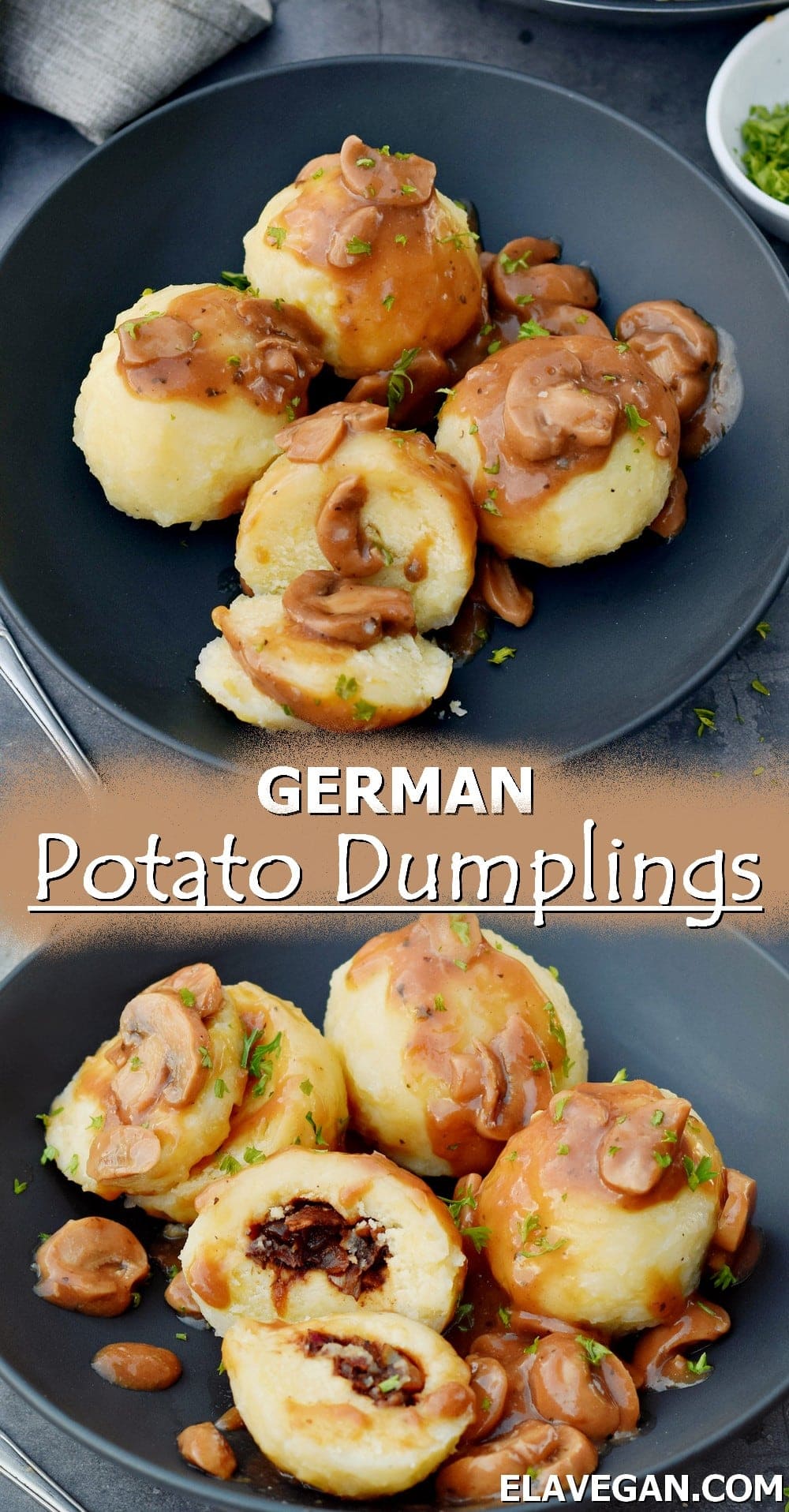

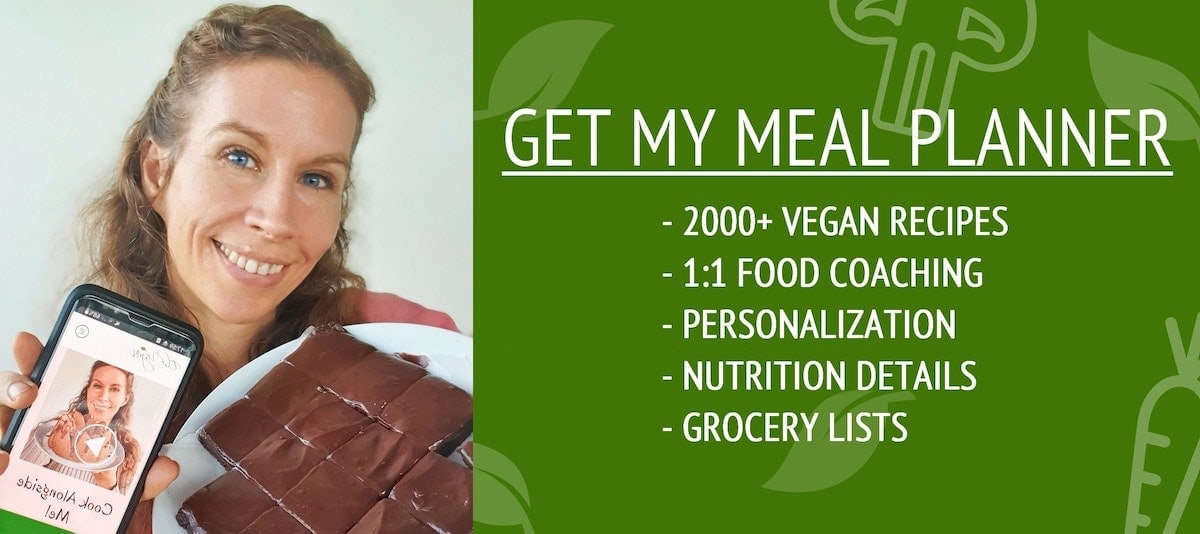


I like this recipe but I am not sure if the amount of starch is correct. All I had was cornstarch, so that’s what I used. I only used about half of the amount and the potatoes got really gooey and sticky.
Hi Vicky, what kind of potatoes did you use? I recommend all-purpose potatoes like Yukon Gold or starchy potatoes like Russet. 🙂
the serving size please.
1 serving is 1 potato dumpling. 🙂
Have you ever used this dough to make a Knedle, Czech style? I’d love to be able to make one glluten free for my partner who misses them.
Thanks for your creativity!
Hey, as far as I know, we used a very similar recipe to make „bramborové knedlíky“. However, I will ask my mom, as she is from the Czech Republic, and will get back to you tomorrow! 🙂
Edit: My mom said it should work. You can shape the dough into logs, wrap them in plastic wrap + tin foil and then boil them.
Please share the mushroom gravy recipe you shushed for this recipe. Looks amazing!
Hi Jill, it’s linked in the post and in the recipe notes 🙂
Hi! I was reading thru the comments and someone mentioned that tapioca starch is different from tapioca flour, and you mentioned in the notes that they are the same, but in the recipe you used potato starch. So I’m wondering if you meant Tapioca starch in the recipe. Or do they all work?
thanks!
Hi April, as mentioned in the recipe notes, I made numerous versions, but prefer the one with potato starch. The tapioca version works great too! 🙂
PS: As far as I know, tapioca flour and tapioca starch are the same! There is a difference between cassava flour and tapioca though! Here is an explanation: https://www.bobsredmill.com/blog/special-diets/what-is-it-wednesday-tapioca-flourstarch/
I love the recipe, so easy and the notes were perfect advice. Just a question for clarification – if using cornstarch, do I mash the potatoes with the peel on or boil them with the peel on? Thank you so much!
Hi Leah, it’s best to boil them with the peel, then peel and then mash. 🙂
Thank you so much!
I increased the quantities so that I could try them both ways: chilled & fried in butter, as well as coming poached right out of the water. Both ways turned out perfectly. The fresh dumplings were light and fluffy; the chilled dumplings were nice and firm and cut easily. I appreciated the notes, especially the specified water temperature, and the photos. I’m going to try them stuffed with your mushroom recipe next. My only change is to add a little more nutmeg. The “pinch” called for tasted great in the dough but was not noticeable in the cooked dumplings. I solved this for the fried slices by sprinkling a tiny bit of nutmeg over them as they fried, but will add a bit more to the dough next time.
That’s awesome, Randi! Thanks so much for your thorough feedback. 🙂
I’d like to try stuffing them next time. How do you cover/seal a dumpling once you’ve added the stuffing? Do you put another layer of potato dough on top? I can’t find a video.
Hi Randi, just make a deep hole in the dumpling with your thumb, then add the filling, push it down with the back of a teaspoon, and then you can close it. 🙂
Loved this Recipe. Will try it soon. A lot leaks through from Germany to my home country Norway. The potato dumpling has its own religious following here; beginning from sort-of-plain in the south – filled with pork side, to more and more starch and then fish and onion as you go west and north. I just made a huge batch of the south-type. Lots of potatoes peeled and crushed through a meat grinder. Sieve off some of the water. Add barley flour until a slightly sticky. Make large ball (snowball sized) filled with pork side (like bacon, but not smoked) cut into pieces and gently lower into water/broth for about 45-60 min. These guys won’t give up even if you do boil them. We serve this as a whole meal – just add salt and butter. Some deviants use sugar or even syrup with this – thats diversity I guess.
Hello Chef
Greetings from Brazil. I am a big fan of your Blog and I have tried (and enjoyed a l9t) many of your recipes. So thank you very much for sharing. You have been helped a lot of people, believe me.
I would like to make an observation though: tapioca flour is notnthe same aa tapioca starch. Both come from cassava decantation, but while part is dried and then grounded (the flour) the other part is fermented before going through drying and grinding., which will give a more intense and sour taste and also it may give some crunchiness to biscuits, bread, etc. We call the tapioca flour here as “polvilho doce” and the starch is called Polvilho Azedo.
I hope you don’t mind my silly note Chef.
Merry Christmas and an amazing New Year.
Thanks for sharing, Izabel! Very interesting! Merry Christmas and have a great New Year! 🙂
Hi Ela, do you have the instructions for the sauce? Thanks
Hi Lilou, it’s linked in the recipe notes. Click on “Mushroom Gravy” to get to the recipe. 🙂
hi there! i’m so sorry to bother but i was wondering whether seven servings means that seven dumplings are created or there is enough for seven plates? again, i’m sorry to bother, and i hope you have a great weekend!
– stella
Hi Stella, no worries! The recipe makes 6 to 8 dumplings, depending on size, so 7 is the average. I hope this helps. 🙂
Hi! How much salt do you use in the dough? To taste is a little vague if you’ve never made them before…
Thanks
It really depends, I am using 3/4 to 1 tsp but it’s best if you simply try a tiny bit of the dough because every taste differs. 🙂
This is such a simple and easy recipe. And the results are so yummy! Just made these dumplings today (plain without any stuffing) and had to stop myself from finishing them all ????. I actually made more dough as I boiled more potatoes so kept half of the dough in the fridge to make some more later. Thanks for the recipe, Ela!
That’s wonderful, Milda! I am so glad they turned out delicious. Thanks for your feedback. 🙂
These look amazing! They are on my list. Are there any tricks to stuffing them?
Thank you!
Hi Teresa! No trick, I just made a “hole” with my thumb and added the filling. Check the step-by-step photos. 🙂
Hope this helps. 🙂
Have you ever tried steaming them instead of “not boiling”? I think that would leave more of the nutrients in the dumplings instead of diluted in the water…
This kind of dumplings were very common here in Sweden when I grew up – my mom used to make them quite often. We call them “kroppkakor” here and they are (or were; they are not so common anymore) served with lingonberry jam and pork. Also often stuffed with pork. But I come from a vegetarian family and my mom stuffed them just as you described! :o) I’ve never made them myself before, but now I definitively have make them!
Hello Anneli! That is a good question, however, I never tried steaming them. It might work well but it will probably take much longer. Could you please report back if you give the steaming method a try? 🙂
OK wow – I made this Potato Dumplings and they turned out soo good! The consistency is great, I loved it. *I wish I had leftovers!* And they are super easy to make. Thank you Ela for this amazing recipe!
Yay, that’s awesome! I am so glad they turned out delicious. Thanks for your feedback! 🙂
Yes…very delicious indeed! In Cuba we have something similar but with meat! Ground beef to be exact! The potato ball or (papa rellena) is the same exact thing but with ground beef inside the rolled in egg and breaded then fried! If you’ve ever had Portos here in California… you know what I mean! But nothing beats mom’s potato balls!!!
Can’t wait to make these! My grandma made them all the time using leftover mashed potatoes
Hi Sally! Yes, they are amazing and perfect for using leftover mashed potatoes. Enjoy! 🙂
In Serbia and other ex Yugoslavian countries we have knedle. Usually filled with plums but can be filled with other fruit like cherries or apricots. Potatoes+flour+egg for dough but I am about to try to make a vegan version this week. Once they are boiled they get fried with bread crumbs and sprinkled with sugar.
Yes, that’s also very common in Germany and in the Czech Republic, but they’re made with flour and yeast. I posted a similar recipe on my blog, just in case you want to check it out.
I think this delicious side dish, would be easier to follow for some people if mmthere was anoche of what Type of potatoes to use, and water temperatura to cook them. . However I think I will try them for sure. Thank you. Its a great and East recepie , ellos Y like potatoes gnoqui.
Dayl, the type of potato is mentioned in the blog post and in the recipe. Also, I mentioned that the water should not boil. I didn’t use a thermometer, however, water boils at 100 degrees Celsius (212 degrees F) and simmers at 90 degrees C (194 degrees F), which means it must be below 90 degrees C, I would say around 80-85 degrees C (176-185 degrees F) would be fine. Hope this helps! 🙂